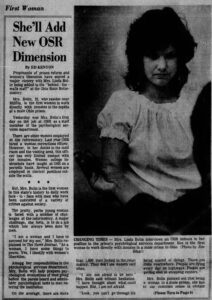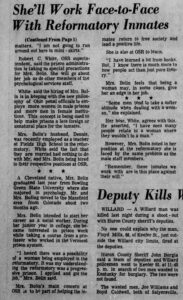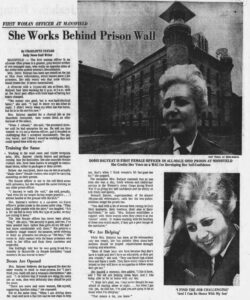She’ll Add New OSR Dimension
She’ll Add New OSR Dimension
By: Ed Kenyon
Proponents of prison reform and women’s liberation have scored a major victory Mrs. Linda Bolin being added to the “behind-the-walls staff” at the Ohio State Reformatory.
Mrs. Bolin, 22, who resides near Mifflin, is the first woman to work directly with inmates in the depths of a male Ohio prison.
Yesterday was Mrs. Bolin’s first day on the job at OSR, as a staff member of the psychological services department.
There are other women employed at the Reformatory. Last year OSR hired a woman corrections officer. However, in her duties in the mail room and the visiting area, this officer has only limited contact with the inmates. Women college instructors have taught at OSR on a periodic basis. Several women are employed in clerical positions outside the walls.
But, Mrs. Bolin is the first woman in this state’s history to daily work face-to-face with men who have been convicted of a variety of crimes against society. The pretty, petite young woman is faced with a number of challenges at the Reformatory. A major challenge, she feels is to do a job which has always been done by men.
“I am a woman and I have to succeed for my sex,” Mrs. Bolin explained to The News Journal. “As a woman, I have some things to prove. Yes, I identify with women’s liberation.
Among her responsibilities in the psychological services department. Mrs. Bolin will help prepare psychological evaluations of men going before the parole and administers psychological tests to men entering the institution.
On the average, there are more than 1,600 men locked in the Reformatory. They don’t see women very often.
“I am not afraid to be here.” Mrs. Bolin said without hesitation. “I have thought about what could happen. But I am not afraid.”
“Look, you can’t go through life being scared of things. There are risks everywhere. People are dying every day on highways. People are getting shot in shopping centers.”
Mrs. Bolin pointed out that being a woman in a male prison, she has to use common sense in certain matters. “I am not going to run around out here in mini-skirts.”
Robert C. White, OSR superintendent, said the prison administration is taking no special precautions for Mrs. Bolin. She will go about her job as do other members of the psychological services staff.
White said the hiring of Mrs. Bolin is in keeping with the new philosophy of Ohio penal officials to employe more women in male prisons and more men in the female institutions. This concept is being used to help make prisons a less foreign or unnatural place for the inmates.
Mrs. Bolin’s husband, Dennis, was recently employed as a teacher at Fields High School in the Reformatory. White said the fact that they are married had nothing to do with Mr. and Mrs. Bolin being hired to their respective positions at OSR.
A Cleveland native, Mrs. Bolin graduated last year from Bowling Green State University where she majored in psychology. Mr. and Mrs. Bolin moved to the Mansfield area from Colorado about two months ago.
Mrs. Bolin intended to start her career as a social worker. During her junior year in college, she became interested in prison work while taking a course from a professor who worked in the Vermont prison system.
“I heard there was a possibility of a woman being employed in the Reformatory. It was my understanding that the Reformatory was a progressive prison. I applied and got the job,” Mrs. Bolin said.
Mrs. Bolin’s main concern at OSR is to be part of helping the inmates return to free society and lead a positive life.
She is also at OSR to learn.
“I have learned a lot from books. But I know there is much more to how people act than just pure theory.
Mrs. Bolin feels that being a woman may, in some cases giver her an edge in her job.
“Some men tend to take a softer attitude when dealing with a woman,” she explained.
Her boss, White, agrees with this. He asserted, “I have seen many people relate to a woman where they wouldn’t a man.”
However, Mrs. Bolin noted in her position at the Reformatory she is face by the same problem as the male staff members.
“Remember, these inmates we work with are in this place against their will.”


